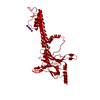[English] 日本語
 Yorodumi
Yorodumi- EMDB-22200: Cryo-EM structure of the G protein-gated inward rectifier K+ chan... -
+ Open data
Open data
- Basic information
Basic information
| Entry | Database: EMDB / ID: EMD-22200 | |||||||||
|---|---|---|---|---|---|---|---|---|---|---|
| Title | Cryo-EM structure of the G protein-gated inward rectifier K+ channel GIRK2 (Kir3.2) in complex with PIP2 | |||||||||
 Map data Map data | Cryo-EM structure of the G protein-gated inward rectifier K+ channel GIRK2 | |||||||||
 Sample Sample |
| |||||||||
 Keywords Keywords | G protein-coupled inwardly rectifying potassium channels / PIP2 / MEMBRANE PROTEIN | |||||||||
| Function / homology |  Function and homology information Function and homology informationG-protein activated inward rectifier potassium channel activity / Activation of G protein gated Potassium channels / Inhibition of voltage gated Ca2+ channels via Gbeta/gamma subunits / inward rectifier potassium channel complex / voltage-gated monoatomic ion channel activity involved in regulation of presynaptic membrane potential / inward rectifier potassium channel activity / parallel fiber to Purkinje cell synapse / potassium channel activity / negative regulation of insulin secretion / presynapse ...G-protein activated inward rectifier potassium channel activity / Activation of G protein gated Potassium channels / Inhibition of voltage gated Ca2+ channels via Gbeta/gamma subunits / inward rectifier potassium channel complex / voltage-gated monoatomic ion channel activity involved in regulation of presynaptic membrane potential / inward rectifier potassium channel activity / parallel fiber to Purkinje cell synapse / potassium channel activity / negative regulation of insulin secretion / presynapse / presynaptic membrane / postsynapse / membrane Similarity search - Function | |||||||||
| Biological species |  | |||||||||
| Method | single particle reconstruction / cryo EM / Resolution: 3.3 Å | |||||||||
 Authors Authors | Niu Y / Tao X | |||||||||
| Funding support |  United States, 1 items United States, 1 items
| |||||||||
 Citation Citation |  Journal: Elife / Year: 2020 Journal: Elife / Year: 2020Title: Cryo-EM analysis of PIP regulation in mammalian GIRK channels. Authors: Yiming Niu / Xiao Tao / Kouki K Touhara / Roderick MacKinnon /  Abstract: G-protein-gated inward rectifier potassium (GIRK) channels are regulated by G proteins and PIP. Here, using cryo-EM single particle analysis we describe the equilibrium ensemble of structures of ...G-protein-gated inward rectifier potassium (GIRK) channels are regulated by G proteins and PIP. Here, using cryo-EM single particle analysis we describe the equilibrium ensemble of structures of neuronal GIRK2 as a function of the C8-PIP concentration. We find that PIP shifts the equilibrium between two distinguishable structures of neuronal GIRK (GIRK2), extended and docked, towards the docked form. In the docked form the cytoplasmic domain, to which G binds, becomes accessible to the cytoplasmic membrane surface where G resides. Furthermore, PIP binding reshapes the G binding surface on the cytoplasmic domain, preparing it to receive G. We find that cardiac GIRK (GIRK1/4) can also exist in both extended and docked conformations. These findings lead us to conclude that PIP influences GIRK channels in a structurally similar manner to Kir2.2 channels. In Kir2.2 channels, the PIP-induced conformational changes open the pore. In GIRK channels, they prepare the channel for activation by G. | |||||||||
| History |
|
- Structure visualization
Structure visualization
| Movie |
 Movie viewer Movie viewer |
|---|---|
| Structure viewer | EM map:  SurfView SurfView Molmil Molmil Jmol/JSmol Jmol/JSmol |
| Supplemental images |
- Downloads & links
Downloads & links
-EMDB archive
| Map data |  emd_22200.map.gz emd_22200.map.gz | 229.4 MB |  EMDB map data format EMDB map data format | |
|---|---|---|---|---|
| Header (meta data) |  emd-22200-v30.xml emd-22200-v30.xml emd-22200.xml emd-22200.xml | 13.7 KB 13.7 KB | Display Display |  EMDB header EMDB header |
| Images |  emd_22200.png emd_22200.png | 31.6 KB | ||
| Filedesc metadata |  emd-22200.cif.gz emd-22200.cif.gz | 6 KB | ||
| Archive directory |  http://ftp.pdbj.org/pub/emdb/structures/EMD-22200 http://ftp.pdbj.org/pub/emdb/structures/EMD-22200 ftp://ftp.pdbj.org/pub/emdb/structures/EMD-22200 ftp://ftp.pdbj.org/pub/emdb/structures/EMD-22200 | HTTPS FTP |
-Validation report
| Summary document |  emd_22200_validation.pdf.gz emd_22200_validation.pdf.gz | 605.2 KB | Display |  EMDB validaton report EMDB validaton report |
|---|---|---|---|---|
| Full document |  emd_22200_full_validation.pdf.gz emd_22200_full_validation.pdf.gz | 604.8 KB | Display | |
| Data in XML |  emd_22200_validation.xml.gz emd_22200_validation.xml.gz | 5.7 KB | Display | |
| Data in CIF |  emd_22200_validation.cif.gz emd_22200_validation.cif.gz | 6.8 KB | Display | |
| Arichive directory |  https://ftp.pdbj.org/pub/emdb/validation_reports/EMD-22200 https://ftp.pdbj.org/pub/emdb/validation_reports/EMD-22200 ftp://ftp.pdbj.org/pub/emdb/validation_reports/EMD-22200 ftp://ftp.pdbj.org/pub/emdb/validation_reports/EMD-22200 | HTTPS FTP |
-Related structure data
| Related structure data |  6xitMC  6xisC C: citing same article ( M: atomic model generated by this map |
|---|---|
| Similar structure data |
- Links
Links
| EMDB pages |  EMDB (EBI/PDBe) / EMDB (EBI/PDBe) /  EMDataResource EMDataResource |
|---|---|
| Related items in Molecule of the Month |
- Map
Map
| File |  Download / File: emd_22200.map.gz / Format: CCP4 / Size: 244.1 MB / Type: IMAGE STORED AS FLOATING POINT NUMBER (4 BYTES) Download / File: emd_22200.map.gz / Format: CCP4 / Size: 244.1 MB / Type: IMAGE STORED AS FLOATING POINT NUMBER (4 BYTES) | ||||||||||||||||||||||||||||||||||||||||||||||||||||||||||||||||||||
|---|---|---|---|---|---|---|---|---|---|---|---|---|---|---|---|---|---|---|---|---|---|---|---|---|---|---|---|---|---|---|---|---|---|---|---|---|---|---|---|---|---|---|---|---|---|---|---|---|---|---|---|---|---|---|---|---|---|---|---|---|---|---|---|---|---|---|---|---|---|
| Annotation | Cryo-EM structure of the G protein-gated inward rectifier K+ channel GIRK2 | ||||||||||||||||||||||||||||||||||||||||||||||||||||||||||||||||||||
| Projections & slices | Image control
Images are generated by Spider. | ||||||||||||||||||||||||||||||||||||||||||||||||||||||||||||||||||||
| Voxel size | X=Y=Z: 1 Å | ||||||||||||||||||||||||||||||||||||||||||||||||||||||||||||||||||||
| Density |
| ||||||||||||||||||||||||||||||||||||||||||||||||||||||||||||||||||||
| Symmetry | Space group: 1 | ||||||||||||||||||||||||||||||||||||||||||||||||||||||||||||||||||||
| Details | EMDB XML:
CCP4 map header:
| ||||||||||||||||||||||||||||||||||||||||||||||||||||||||||||||||||||
-Supplemental data
- Sample components
Sample components
-Entire : Homo-tetrameric assembly of G protein-activated inward rectifier ...
| Entire | Name: Homo-tetrameric assembly of G protein-activated inward rectifier potassium channel 2 |
|---|---|
| Components |
|
-Supramolecule #1: Homo-tetrameric assembly of G protein-activated inward rectifier ...
| Supramolecule | Name: Homo-tetrameric assembly of G protein-activated inward rectifier potassium channel 2 type: complex / ID: 1 / Parent: 0 / Macromolecule list: #1 |
|---|---|
| Source (natural) | Organism:  |
-Macromolecule #1: G protein-activated inward rectifier potassium channel 2
| Macromolecule | Name: G protein-activated inward rectifier potassium channel 2 type: protein_or_peptide / ID: 1 / Number of copies: 4 / Enantiomer: LEVO |
|---|---|
| Source (natural) | Organism:  |
| Molecular weight | Theoretical: 39.061957 KDa |
| Recombinant expression | Organism:  Komagataella pastoris (fungus) Komagataella pastoris (fungus) |
| Sequence | String: MAKRKIQRYV RKDGKCNVHH GNVRETYRYL TDIFTTLVDL KWRFNLLIFV MVYTVTWLFF GMIWWLIAYI RGDMDHIEDP SWTPCVTNL NGFVSAFLFS IETETTIGYG YRVITDKCPE GIILLLIQSV LGSIVNAFMV GCMFVKISQP KKRAETLVFS T HAVISMRD ...String: MAKRKIQRYV RKDGKCNVHH GNVRETYRYL TDIFTTLVDL KWRFNLLIFV MVYTVTWLFF GMIWWLIAYI RGDMDHIEDP SWTPCVTNL NGFVSAFLFS IETETTIGYG YRVITDKCPE GIILLLIQSV LGSIVNAFMV GCMFVKISQP KKRAETLVFS T HAVISMRD GKLCLMFRVG DLRNSHIVEA SIRAKLIKSK QTSEGEFIPL NQTDINVGYY TGDDRLFLVS PLIISHEINQ QS PFWEISK AQLPKEELEI VVILEGMVEA TGMTCQARSS YITSEILWGY RFTPVLTLED GFYEVDYNSF HETYETSTPS LSA KELAEL ANRAESNSLE VLFQ UniProtKB: G protein-activated inward rectifier potassium channel 2 |
-Macromolecule #2: [(2R)-2-octanoyloxy-3-[oxidanyl-[(1R,2R,3S,4R,5R,6S)-2,3,6-tris(o...
| Macromolecule | Name: [(2R)-2-octanoyloxy-3-[oxidanyl-[(1R,2R,3S,4R,5R,6S)-2,3,6-tris(oxidanyl)-4,5-diphosphonooxy-cyclohexyl]oxy-phosphoryl]oxy-propyl] octanoate type: ligand / ID: 2 / Number of copies: 4 / Formula: PIO |
|---|---|
| Molecular weight | Theoretical: 746.566 Da |
| Chemical component information | 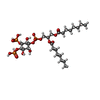 ChemComp-PIO: |
-Macromolecule #3: POTASSIUM ION
| Macromolecule | Name: POTASSIUM ION / type: ligand / ID: 3 / Number of copies: 3 / Formula: K |
|---|---|
| Molecular weight | Theoretical: 39.098 Da |
-Experimental details
-Structure determination
| Method | cryo EM |
|---|---|
 Processing Processing | single particle reconstruction |
| Aggregation state | particle |
- Sample preparation
Sample preparation
| Concentration | 6 mg/mL |
|---|---|
| Buffer | pH: 7.5 Details: 20 mM Tris-HCl pH 7.5, 150 mM KCl, 10 mM DTT, 1 mM DETA, 0.2% DM and 0.01% CHS |
| Grid | Model: Quantifoil R1.2/1.3 / Material: GOLD / Mesh: 400 / Support film - Material: CARBON / Support film - topology: HOLEY / Pretreatment - Type: GLOW DISCHARGE |
| Vitrification | Cryogen name: ETHANE / Chamber humidity: 95 % / Chamber temperature: 298 K / Instrument: FEI VITROBOT MARK IV |
- Electron microscopy
Electron microscopy
| Microscope | FEI TITAN KRIOS |
|---|---|
| Image recording | Film or detector model: GATAN K2 SUMMIT (4k x 4k) / Detector mode: SUPER-RESOLUTION / Digitization - Frames/image: 1-50 / Number grids imaged: 1 / Number real images: 11349 / Average exposure time: 10.0 sec. / Average electron dose: 8.0 e/Å2 |
| Electron beam | Acceleration voltage: 300 kV / Electron source:  FIELD EMISSION GUN FIELD EMISSION GUN |
| Electron optics | C2 aperture diameter: 100.0 µm / Illumination mode: FLOOD BEAM / Imaging mode: BRIGHT FIELD |
| Sample stage | Specimen holder model: FEI TITAN KRIOS AUTOGRID HOLDER / Cooling holder cryogen: NITROGEN |
| Experimental equipment |  Model: Titan Krios / Image courtesy: FEI Company |
 Movie
Movie Controller
Controller


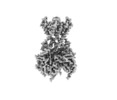




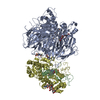
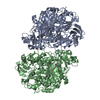
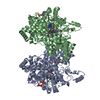

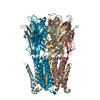
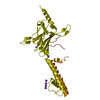


 Z (Sec.)
Z (Sec.) Y (Row.)
Y (Row.) X (Col.)
X (Col.)





















